by Aoife Donnellan // Nov. 14, 2023
This article is part of our feature topic Myth.
‘Deserters’ (2023) at Kunsthaus Baselland is a live installation by Italian artist Chiara Bersani, that uses tapestry, performance and textile works to recentre bodies with disabilities in mythology as well as their relationship to nature. Curated by Lorenzo Giusti and Ines Goldbach, the exhibition combines architectural practices with performance and soundscape to create an intimate space that extends beyond its physical boundaries. Produced during the artist’s residency in Bergamo, it was the winning project of the 11th edition of the Italian Council, a program aimed at supporting Italian contemporary art in the world. Bersani’s practice combines research, theatre and the visual arts to create an interactive performance space that encourages physical dialogue.
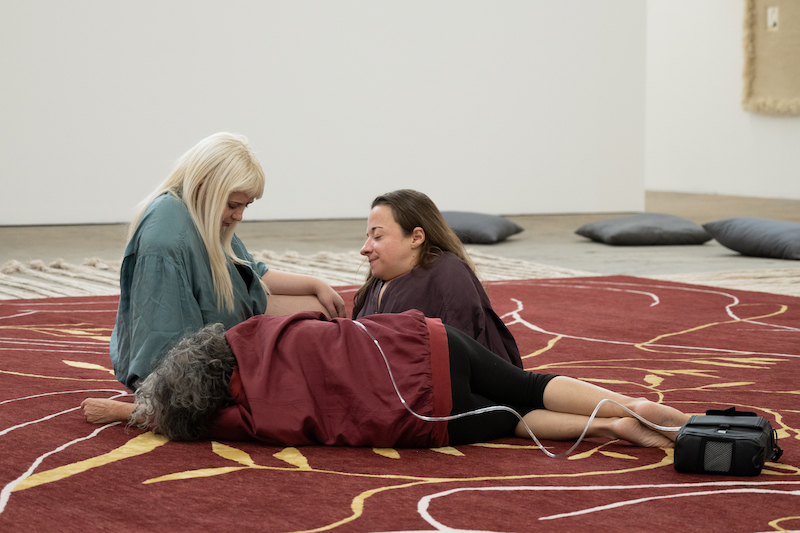
Chiara Bersani: ‘Deserters,’ 2023 // Photo by Pati Grabowicz, courtesy of Kunsthaus Baselland
The exhibition takes its name from Virginia Woolf’s essay ‘On Being Ill’ (1926), which notes that when someone experiences chronic illness they “cease to be soldiers in the army of the upright”—rendering them deserters. This defiance of the upright individualistic perspective is considered materially throughout the exhibition, which chooses instead to centre horizontal communality. A hand-knotted Nepalese tapestry, made in collaboration with CC-tapis, fills the majority of the exhibition floor. A medium historically used to capture epic and mythic characters and journeys, this rendition is placed on the ground and audience members are invited to remove their shoes and move across the surface. The red background is filled with images in gold, mimicking the Italian arazzo tradition. It depicts people intertwined with growing vines, while long fringes of yarn on each side stretch out into the space. Each fringe—acting as both a barrier and an invitation—is two-metres-long and fragile if mishandled. The image is designed so that the lines can be felt underfoot as you move across it.
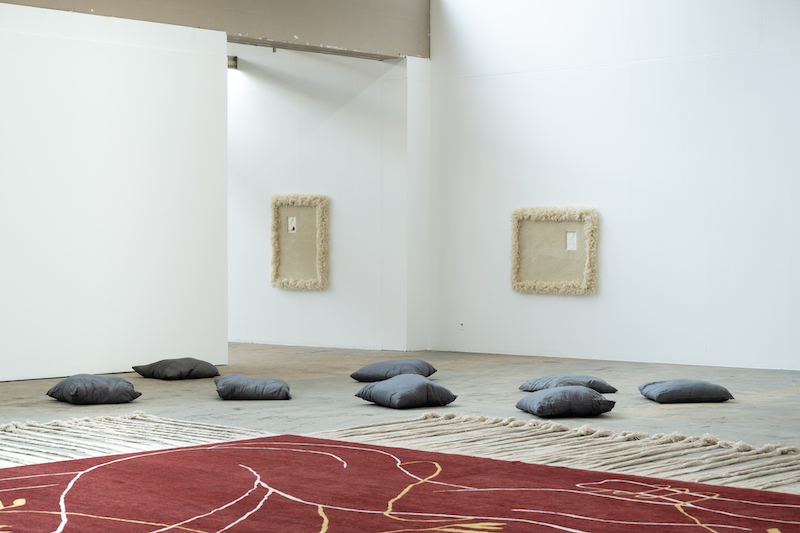
Chiara Bersani: ‘Deserters,’ 2023 // Photo by Finn Curry, courtesy of Kunsthaus Baselland
In an interview with Goldbach, Bersani explains that she began working on the piece out of an urgent need to represent “how bodies dissonant from the norm have no collective history to speak of their past. They don’t have legends, myths, heroes and heroines.” In this absence of collective narrative, Bersani created a space where traces of those who moved across the surface were left behind to be picked up by others. This intergenerational connection between bodies in space is furthered by the materiality of the work. Bersani explains that in this way, she captures a sense of stewardship for “all the bodies that have crossed the Earth without enjoying it.” Nearby, an audio description of the work written by Camilla Guarino in collaboration with Giuseppe Comuniello and Bersani, available in both English and German, provides both physical and evocative descriptions, to capture a sense of the spirit of the work as well as the material conditions.
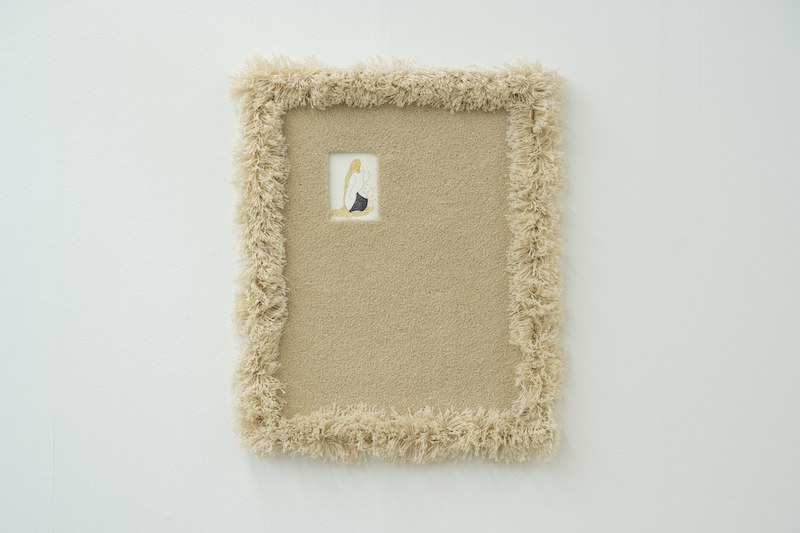
Chiara Bersani: ‘Deserters,’ 2023 // Photo by Finn Curry, courtesy of Kunsthaus Baselland
The performance element of the exhibition was staged primarily on the tapestry and was performed by Bersani and two other performers with motor impairments, Anna Maria Pes and Chiara Pintus. The soundscape that accompanied the performance, and which is available to listen to during the exhibition, was created in collaboration with Italian composer and sound researcher Ilaria Lemmo. In the space, gentle encounters unfolded between performers as they rested on one another, breathing and sighing together. A small chorus of sighs, moans and giggles was fostered between them, culminating in laughter. They made their way from the centre of the tapestry to the fringes, encouraging one another to venture further. The audience could stand or sit on pillows and collapsable chairs at the level of the performance, drawing attention to the choice involved in engagement and perspective. The performers moved throughout the gallery space, finding wordless moments to interact with audience members; resting their heads on a pillow or smiling as they passed by. Their gestures and sounds sought to undermine stereotypes associated with people with disabilities and their relationship to intimacy, joy and desire. The performance’s shifting spatial dynamics examined the universality of vulnerability as a condition of existence. As the performers moved through the space, they invited people to engage or remain passive to their changing proximity. Bersani sought out textile work exhibited on the wall to feel the surface, setting an example for others to do the same. The work encouraged a physical dialogue between bodies, both performers and audience, as they exchanged thoughts and ideas about the past, present and future of normative modes of existence.
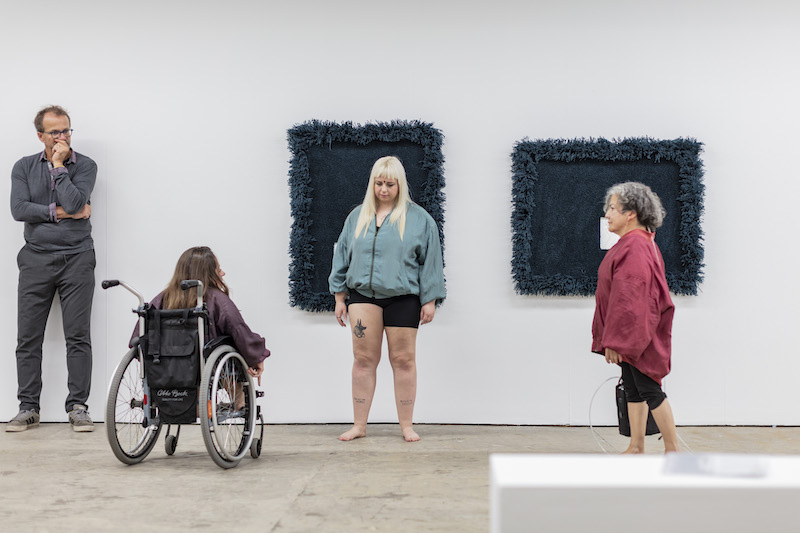
Chiara Bersani: ‘Deserters,’ 2023 // Photo by Pati Grabowicz, courtesy of Kunsthaus Baselland
The textile and drawing works, exhibited at an accessible height around the tapestry, as well as at the back of the exhibition space, are a combination of machine-woven tapestries and drawings on paper that depict bodies with various disabilities. Each drawing sits off-centre in the frame, remaining on the edge of its own display. The size of each drawing in comparison to its material frame draws visitors closer to inspect the detail. The large, textured void surrounding each piece mimics the shared social sphere inhabited by bodies in space. An invitation to interact physically with the work continues throughout the exhibition as visitors are welcomed to touch each textile work. The coarse material holds the shape of the movement after the interaction has ceased. These moments of physical connection with the work are central to its success. Experiencing and altering the material condition of each work for the next visitor illuminates the interdependence of bodies through both time and space.
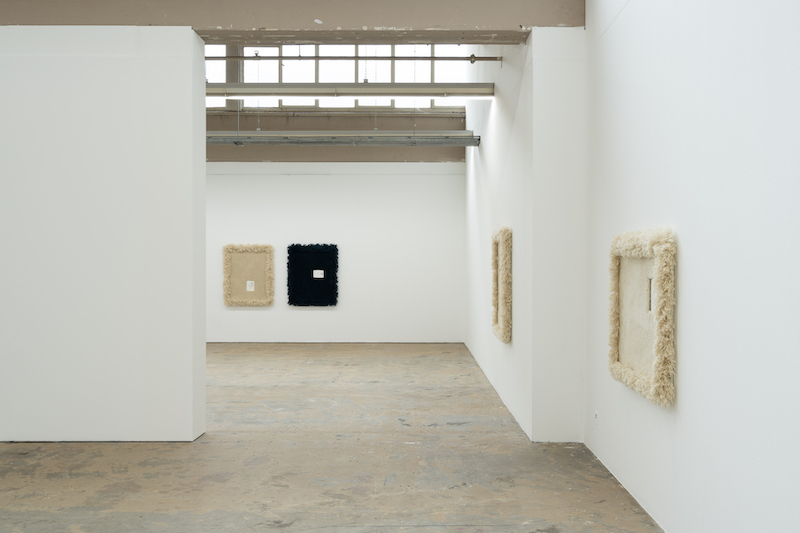
Chiara Bersani: ‘Deserters,’ 2023 // Photo by Finn Curry, courtesy of Kunsthaus Baselland
‘Deserters’ combines the essential vulnerability of bodily existence with the importance of maintaining a communal perspective. Both Bersani’s performance and installation work extend temporal and spatial boundaries, capturing the movements left by bodies in their wake. Through this haptic motion, Bersani’s practice considers the importance of myth-making for collective identity building as well as the responsibility to remember those who are not commonly memorialised.
Artist Info
Exhibition Info
Kunsthaus Baselland
Chiara Bersani: ‘Deserters’
Exhibition: Oct. 27, 2023–Jan. 4, 2024
kunsthausbaselland.ch
St. Jakob-Strasse 170, CH-4132 Muttenz/Basel, click here for map





















